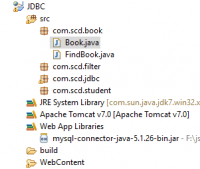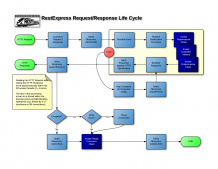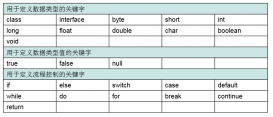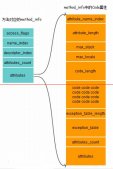前言
目前正在出一个Es专题系列教程, 篇幅会较多, 请持续关注服务器之家
本节来给大家讲一下在Springboot中如何整合es~
本文偏实战一些,为了方便演示,本节示例沿用上节索引,好了, 废话不多说直接开整吧~
项目搭建
老规矩,先建maven项目,下面是我的pom.xml
|
1
2
3
4
5
6
7
8
9
10
11
12
13
14
15
16
17
18
19
20
21
22
23
24
25
26
27
28
29
30
31
32
33
34
35
36
37
38
39
40
41
42
43
44
45
46
47
48
49
50
51
52
53
54
55
56
57
58
59
60
61
62
63
64
65
66
67
68
69
70
71
72
73
74
75
76
|
<?xml version="1.0" encoding="UTF-8"?><project xmlns="http://maven.apache.org/POM/4.0.0" xmlns:xsi="http://www.w3.org/2001/XMLSchema-instance" xsi:schemaLocation="http://maven.apache.org/POM/4.0.0 http://maven.apache.org/xsd/maven-4.0.0.xsd"> <modelVersion>4.0.0</modelVersion> <groupId>org.example</groupId> <artifactId>springboot-es-all</artifactId> <version>1.0-SNAPSHOT</version> <properties> <java.version>1.8</java.version> </properties> <parent> <groupId>org.springframework.boot</groupId> <artifactId>spring-boot-starter-parent</artifactId> <version>2.1.3.RELEASE</version> </parent> <dependencies> <!--test--> <dependency> <groupId>org.springframework.boot</groupId> <artifactId>spring-boot-starter-test</artifactId> </dependency> <!--ElasticSearch 客户端依赖--> <dependency> <groupId>org.elasticsearch.client</groupId> <artifactId>elasticsearch-rest-client</artifactId> <version>7.8.0</version> </dependency> <dependency> <groupId>org.elasticsearch</groupId> <artifactId>elasticsearch</artifactId> <version>7.8.0</version> </dependency> <dependency> <groupId>org.elasticsearch.client</groupId> <artifactId>elasticsearch-rest-high-level-client</artifactId> <version>7.8.0</version> </dependency> <!--Hutool依赖--> <dependency> <groupId>cn.hutool</groupId> <artifactId>hutool-all</artifactId> <version>5.8.4</version> </dependency> <!--fast-json--> <dependency> <groupId>com.alibaba</groupId> <artifactId>fastjson</artifactId> <version>1.2.58</version> </dependency> <dependency> <groupId> org.slf4j </groupId> <artifactId> slf4j-api </artifactId> <version> 1.6.4 </version> </dependency> <dependency> <groupId>org.slf4j</groupId> <artifactId>slf4j-simple</artifactId> <version>1.7.25</version> <scope>compile</scope> </dependency> <dependency> <groupId>org.projectlombok</groupId> <artifactId>lombok</artifactId> </dependency> </dependencies> <build> <plugins> <plugin> <groupId>org.springframework.boot</groupId> <artifactId>spring-boot-maven-plugin</artifactId> <version>2.1.3.RELEASE</version> </plugin> </plugins> </build></project> |
这里我使用的是elasticsearch-rest-high-level-client官方客户端,建议大家尽量用官方的,因为随着es的不断升级,很多api都过时了,如果你使用spring-boot-starter-data-elasticsearch这个要依赖社区去维护,很多新特性你没法使用到,也会存在安全性问题。
配置客户端
启动类:
|
1
2
3
4
5
6
|
@SpringBootApplicationpublic class EsStudyApplication { public static void main(String[] args) { SpringApplication.run(EsStudyApplication.class, args); }} |
配置文件 application.yml:
|
1
2
3
4
5
6
7
|
server: port: 9000elasticsearch: host: 0.0.0.0 port: 9200 username: password: |
客户端配置 config.EsClientConfig:
|
1
2
3
4
5
6
7
8
9
10
11
12
13
14
15
16
17
18
19
20
21
22
23
24
|
@Configurationpublic class EsClientConfig { @Value("${elasticsearch.host}") private String host; @Value("${elasticsearch.port}") private int port; @Value("${elasticsearch.username}") private String userName; @Value("${elasticsearch.password}") private String password; @Bean public RestHighLevelClient restHighLevelClient() { final CredentialsProvider credentialsProvider = new BasicCredentialsProvider(); credentialsProvider.setCredentials(AuthScope.ANY, new UsernamePasswordCredentials(userName, password)); RestHighLevelClient restHighLevelClient = new RestHighLevelClient( RestClient.builder(new HttpHost( host, port, "http")).setHttpClientConfigCallback(httpClientBuilder -> { httpClientBuilder.setMaxConnTotal(500); httpClientBuilder.setMaxConnPerRoute(300); return httpClientBuilder.setDefaultCredentialsProvider(credentialsProvider); }) ); return restHighLevelClient; }} |
然后客户端我们就配好了,客户端的配置其实还有很多,感兴趣的同学自行查阅。后续使用的时候,直接导入RestHighLevelClient实例就好了
接着启动它,如果控制没有报错,说明配置没啥问题了, 记得要开启es服务~
索引API初探 & Index API
下面我们写一点测试用例,来验证我们是否可以操作es,为了方便演示,这里直接使用SpringBootTest来测试,大家平时在写springboot项目,类测试的时候也可以这么做
ping
新建api.IndexApi,调用ping()方法来测试是否链接成功:
|
1
2
3
4
5
6
7
8
9
10
11
12
13
14
15
16
17
18
|
@Slf4j@SpringBootTestpublic class IndexApi { /** * es 索引 */ public static final String index = "study"; @Autowired private RestHighLevelClient client; @Test public void ping() throws IOException { if(client.ping(RequestOptions.DEFAULT)) { log.info("链接成功"); }else { log.info("链接失败 !"); } }} |
点击IndexApi左上角的绿色箭头启动测试用例, 如果报错,尝试添加以下 注解
|
1
2
3
|
@RunWith(SpringRunner.class)@SpringBootTest(classes = { EsStudyApplication.class })public class IndexApi {....} |
返回:
链接成功
说明客户端与es服务端是通的
创建索引 & create
通过前面的学习,有了一定的基础之后,回到代码中其实就是调调方法,因为你知道了这个代码的逻辑做了什么操作。下面来看下如何创建索引:
|
1
2
3
4
5
6
7
8
9
|
/** * 创建索引 */ @Test public void createIndex() throws IOException { CreateIndexRequest request = new CreateIndexRequest(index); CreateIndexResponse createIndexResponse = client.indices().create(request, RequestOptions.DEFAULT); log.info("创建索引 ===> "+ JSONObject.toJSONString(createIndexResponse)); // 创建索引 ===> {"acknowledged":true,"fragment":false,"shardsAcknowledged":true} } |
大家可以返回到kibana中查看索引是否被创建,从而验证代码执行是否成功
添加别名:
|
1
2
|
// aliasrequest.alias(new Alias("study_alias")); |
索引设置settings:
|
1
2
3
4
5
6
|
// index settingsrequest.settings( Settings.builder() .put("index.number_of_shards", 3) .put("index.number_of_replicas", 2)); |
索引映射mapping:
|
1
2
3
4
5
6
7
8
9
10
11
12
13
14
15
16
17
18
19
20
21
22
23
24
25
26
27
|
// index mappings// {// "mapping": {// "_doc": {// "properties": {// "name": {// "type": "text"// }// }// }// }// }XContentBuilder builder = XContentFactory.jsonBuilder();builder.startObject();{ builder.startObject("properties"); { builder.startObject("name"); { builder.field("type", "text"); } builder.endObject(); } builder.endObject();}builder.endObject();request.mapping(builder); |
设置请求超时时间:
|
1
2
|
// 请求设置request.setTimeout(TimeValue.timeValueMinutes(1)); |
索引是否存在 & exist
|
1
2
3
4
5
6
7
8
9
10
|
/** * 判断索引是否存在 * @throws IOException */@Testpublic void existIndex() throws IOException { GetIndexRequest request = new GetIndexRequest(index); boolean exists = client.indices().exists(request, RequestOptions.DEFAULT); log.info("索引{}存在 ===> {}", index, exists);} |
删除索引
|
1
2
3
4
5
6
7
8
9
10
|
/** * 删除索引 * @throws IOException */@Testpublic void delIndex() throws IOException { DeleteIndexRequest request = new DeleteIndexRequest(index); AcknowledgedResponse delete = client.indices().delete(request, RequestOptions.DEFAULT); log.info("删除索引 ===> {}", JSONObject.toJSONString(delete)); // 删除索引 ===> {"acknowledged":true,"fragment":false}} |
结束语
下节带大家看下文档操作相关的api,也是我们业务中使用最多的api~
更多关于ElasticSearch整合SpringBoot的资料请关注服务器之家其它相关文章!
原文链接:https://juejin.cn/post/7202441529151094842


















